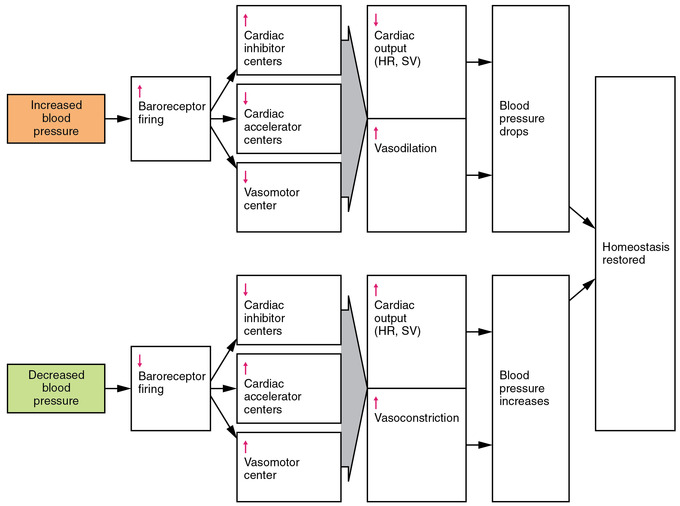Neural regulation of blood pressure is achieved through the role of cardiovascular centers and baroreceptor stimulation.
Learning Objectives
- Describe the role of baroreceptors and cardiovascular centers (ANS) in blood pressure control
Key Points
- The cardioaccelerator center, the cardioinhibitor center, and the vasomotor center form the cardiovascular center, a cluster of neurons that function independently to regulate blood pressure and flow.
- The release of the neurotransmitter norepinephrine from sympathetic neurons directs the majority of neurons associated with the cardiovascular center.
- Baroreceptors respond to the degree of stretch caused by the presence of blood; this stimulates impulses to be sent to the cardiovascular center to regulate blood pressure to achieve homeostasis when needed.
Key Terms
- autonomic nervous system: The part of the nervous system that regulates the involuntary activity of the heart, intestines, and glands. These activities include digestion, respiration, perspiration, metabolism, and blood pressure modulation.
- norepinephrine: A catecholamine with multiple roles including as a hormone and neurotransmitter. Areas of the body that produce or are affected by this substance are described as noradrenergic.
- sympathetic: Of or related to the part of the autonomic nervous system that under stress raises blood pressure and heart rate, constricts blood vessels, and dilates the pupils.
- baroreceptor: A nerve ending that is sensitive to changes in blood pressure.
- parasympathetic: Of or relating to the part of the autonomic nervous system that inhibits or opposes the effects of the sympathetic nervous system.
The autonomic nervous system plays a critical role in the regulation of vascular homeostasis. The primary regulatory sites include the cardiovascular centers in the brain that control both cardiac and vascular functions.
Neurological regulation of blood pressure and flow depends on the cardiovascular centers located in the medulla oblongata. This cluster of neurons responds to changes in blood pressure as well as blood concentrations of oxygen, carbon dioxide, and other factors such as pH.
Baroreceptor Function
Baroreceptors are specialized stretch receptors located within thin areas of blood vessels and heart chambers that respond to the degree of stretch caused by the presence of blood. They send impulses to the cardiovascular center to regulate blood pressure. Vascular baroreceptors are found primarily in sinuses (small cavities) within the aorta and carotid arteries. The aortic sinuses are found in the walls of the ascending aorta just superior to the aortic valve, whereas the carotid sinuses are located in the base of the internal carotid arteries. There are also low-pressure baroreceptors located in the walls of the venae cavae and right atrium.
When blood pressure increases, the baroreceptors are stretched more tightly and initiate action potentials at a higher rate. At lower blood pressures, the degree of stretch is lower and the rate of firing is slower. When the cardiovascular center in the medulla oblongata receives this input, it triggers a reflex that maintains homeostasis.

Baroreceptor Reflexes: Increased blood pressure results in increased rates of baroreceptor firing, whereas decreased blood pressure results in slower rates of fire, both initiating the homeostatic mechanism to restore blood pressure.
Baroreceptor Reflexes
When blood pressure rises too high, baroreceptors fire at a higher rate and trigger parasympathetic stimulation of the heart. As a result, cardiac output falls. Sympathetic stimulation of the peripheral arterioles will also decrease, resulting in vasodilation. Combined, these activities cause blood pressure to fall.
When blood pressure drops too low, the rate of baroreceptor firing decreases. This triggers an increase in sympathetic stimulation of the heart, causing cardiac output to increase. It also triggers sympathetic stimulation of the peripheral vessels, resulting in vasoconstriction. Combined, these activities cause blood pressure to rise.
The baroreceptors in the venae cavae and right atrium monitor blood pressure as the blood returns to the heart from the systemic circulation. Normally, blood flow into the aorta is the same as blood flow back into the right atrium. If blood is returning to the right atrium more rapidly than it is being ejected from the left ventricle, the atrial receptors will stimulate the cardiovascular centers to increase sympathetic firing and cardiac output until homeostasis is achieved. The opposite is also true. This mechanism is referred to as the atrial reflex.
Other neural mechanisms can also have a significant impact on cardiovascular function. These include the limbic system, which links physiological responses to psychological stimuli, chemoreceptor reflexes, generalized sympathetic stimulation, and parasympathetic stimulation.

